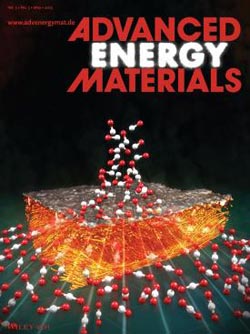New analytical methodology can guide electrode optimization

A 3-D rendering of a gas diffusion electrode, used in fuel cells and CO2 electrolyzers, where a thin, uniform, and crack-free catalyst layer is crucial to efficient operation.<br>
A 3-D rendering of a gas diffusion electrode, used in fuel cells and CO2 electrolyzers, where a thin, uniform, and crack-free catalyst layer is crucial to efficient operation.
“Electrodes play a vital role in all devices based on heterogeneous electrochemical reactions for energy conversion, energy storage, and chemical synthesis,” explained Molly Jhong, a graduate student at the Department of Chemical and Biomolecular Engineering (ChemE) and first author of a paper appearing in Advanced Energy Materials. “The performance and durability of these devices is largely determined by the processes that occur at the catalyst layer-electrolyte interface.
“With this research, we have developed a combined approach of MicroCT-based visualization and microfluidic-based electrochemical analysis that allows changes in electrode performance to be directly correlated to differences in catalyst layer structure,” Jhong added. “This can guide electrode optimization, including improved catalyst utilization, for a variety of electrochemical energy conversion systems.”
The combined approach of MicroCT-based visualization and microfluidic-based electrochemical analysis offers a framework for systematic investigation of electrode-based electrochemical processes such as fuel cells, water electrolyzers to produce hydrogen and oxygen, and carbon dioxide electrolyzers for production of useful chemicals or for energy storage.
The researchers chose X-ray tomography because it provides 3-D material-specific information, in a non-destructive fashion, with high spatial and temporal resolution. This technique has been increasingly employed to better understand, control, and enhance the complex material science that underlies the performance and durability of electrochemical energy technologies.
According to Jhong, the commercialization of polymer-electrolyte membrane fuel cells has been limited by the cathodic oxygen reduction reaction because it requires high loadings of expensive platinum catalyst to achieve performance benchmarks. Similarly, the development of economically-feasible electrochemical reactors to convert carbon dioxide to value-added chemicals requires the advent of catalytic material with high activity and selectivity. Significant efforts have focused on engineering the catalyst layer structure to maximize catalyst utilization as well as overall electrode and system performance for both applications.
“By coupling structural analysis with in-situ electrochemical characterization, we directly correlate variation in catalyst layer morphology to electrode performance,” she said. “MicroCT and scanning electron microscopy analyses indicate that more uniform catalyst distribution and less particle agglomeration, lead to better performance.” This will benefit the development of new materials and improved processing methodologies for catalyst layer deposition and electrode preparation and may lead to economically-viable electrochemical systems to help address climate change and shift society towards the use of renewable energy sources.
The analyses reported in the research allow for the observed differences over a large geometric volume as a function of preparation methods to be quantified and explained for the first time.
“The research reported the state-of-the-art performance of the electrochemical reduction of CO2 to CO: highest conversion, and excellent product selectivity at very low catalyst loading,” Jhong says “The success of improving performance while largely reducing the loading of precious metal catalysts showcases that the combined MicroCT and electrochemical approach works well and does guide electrode optimization.”
In addition to Jhong, authors of the research paper, “The Effects of Catalyst Layer Deposition Methodology on Electrode Performance,” include ChemE professor Paul Kenis, MIT assistant professor and Illinois alumnus Fikile Brushett, and Dr. Leilei Yin, research scientist from the Beckman Institute at Illinois.
Contact: Paul Kenis, Department of Chemical and Biomolecular Engineering University of Illinois at Urbana-Champaign, 217/265-0523.
Writer: Sarah Williams, assistant director of communications, Department of Chemical and Biomolecular Engineering, 217/244-0541.
If you have any questions about the College of Engineering, or other story ideas, contact Rick Kubetz, editor, Engineering Communications Office, University of Illinois at Urbana-Champaign, 217/244-7716.
Media Contact
All latest news from the category: Materials Sciences
Materials management deals with the research, development, manufacturing and processing of raw and industrial materials. Key aspects here are biological and medical issues, which play an increasingly important role in this field.
innovations-report offers in-depth articles related to the development and application of materials and the structure and properties of new materials.
Newest articles

Silicon Carbide Innovation Alliance to drive industrial-scale semiconductor work
Known for its ability to withstand extreme environments and high voltages, silicon carbide (SiC) is a semiconducting material made up of silicon and carbon atoms arranged into crystals that is…

New SPECT/CT technique shows impressive biomarker identification
…offers increased access for prostate cancer patients. A novel SPECT/CT acquisition method can accurately detect radiopharmaceutical biodistribution in a convenient manner for prostate cancer patients, opening the door for more…

How 3D printers can give robots a soft touch
Soft skin coverings and touch sensors have emerged as a promising feature for robots that are both safer and more intuitive for human interaction, but they are expensive and difficult…





















